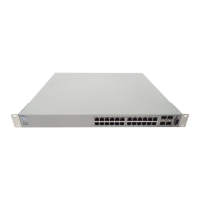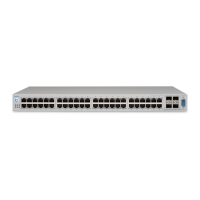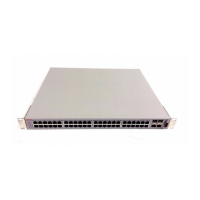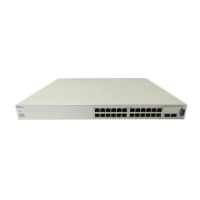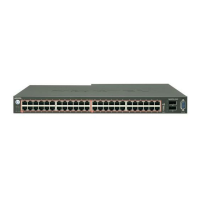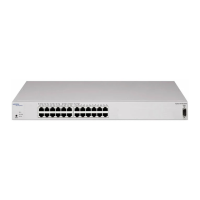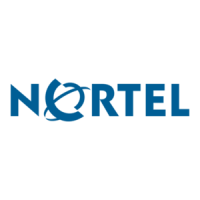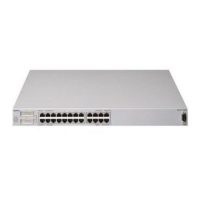Do you have a question about the Nortel 5520 and is the answer not in the manual?
Details fundamental classification limitations and capabilities on the switch.
Explains how to group individual classifiers into blocks for resource management.
Describes how to specify ranges for classification components like port numbers.
Covers policy evaluation order, actions, and system default policies for traffic management.
Details the relationship between bucket size, committed rate, and burst duration.
Explains how to configure traffic policing parameters like rate, burst, and actions.
Describes how to configure interface shaping for traffic egress control.
Outlines general ACL configuration considerations and limitations on the switch.
Details how to configure IP-based Access Control Lists using CLI commands.
Explains the configuration of Layer 2 Access Control Lists for MAC and VLAN criteria.
Describes how to assign configured ACLs to specific ports on the switch.
Provides a practical example of configuring and applying IP ACLs for traffic management.
Explains DHCP snooping for securing network access and preventing rogue servers.
Details Dynamic ARP Inspection to prevent ARP spoofing and MITM attacks.
Describes IP Source Guard for preventing IP address spoofing using DHCP bindings.
Outlines the steps to configure BPDU filtering on access ports for Spanning Tree.
Explains how to configure protection against ARP spoofing attacks on the switch.
Details solutions for DHCP attacks like rogue servers and spoofing.
Covers configuration for various Denial of Service (DoS) attack mitigation applications.
Explains how to enable BPDU blocking on interfaces to prevent network loops.
Describes how to group ports and assign interface classes for policy application.
Details adding IP or L2 classifier elements and creating classifier blocks.
Explains how to add and configure traffic meters for policing and shaping.
Guides on creating new policies by assigning classifiers, meters, and actions.
Lists pre-defined values for QoS actions and IP elements used in configurations.
Demonstrates configuring traffic meters and policies for specific UDP flows.
Comprehensive example integrating multiple security and QoS features across VLANs.
Shows how to use ACLs or policies for port range filtering and traffic remarking.
Illustrates L2 classification based on MAC addresses for service class assignment.
Details combining L2 and L3 classification using policies for specific hosts.
Demonstrates DSCP mapping to egress queues on unrestricted ports using ACLs.
Provides an example of configuring interface shaping for specific port rates.
Details fundamental classification limitations and capabilities on the switch.
Explains how to group individual classifiers into blocks for resource management.
Describes how to specify ranges for classification components like port numbers.
Covers policy evaluation order, actions, and system default policies for traffic management.
Details the relationship between bucket size, committed rate, and burst duration.
Explains how to configure traffic policing parameters like rate, burst, and actions.
Describes how to configure interface shaping for traffic egress control.
Outlines general ACL configuration considerations and limitations on the switch.
Details how to configure IP-based Access Control Lists using CLI commands.
Explains the configuration of Layer 2 Access Control Lists for MAC and VLAN criteria.
Describes how to assign configured ACLs to specific ports on the switch.
Provides a practical example of configuring and applying IP ACLs for traffic management.
Explains DHCP snooping for securing network access and preventing rogue servers.
Details Dynamic ARP Inspection to prevent ARP spoofing and MITM attacks.
Describes IP Source Guard for preventing IP address spoofing using DHCP bindings.
Outlines the steps to configure BPDU filtering on access ports for Spanning Tree.
Explains how to configure protection against ARP spoofing attacks on the switch.
Details solutions for DHCP attacks like rogue servers and spoofing.
Covers configuration for various Denial of Service (DoS) attack mitigation applications.
Explains how to enable BPDU blocking on interfaces to prevent network loops.
Describes how to group ports and assign interface classes for policy application.
Details adding IP or L2 classifier elements and creating classifier blocks.
Explains how to add and configure traffic meters for policing and shaping.
Guides on creating new policies by assigning classifiers, meters, and actions.
Lists pre-defined values for QoS actions and IP elements used in configurations.
Demonstrates configuring traffic meters and policies for specific UDP flows.
Comprehensive example integrating multiple security and QoS features across VLANs.
Shows how to use ACLs or policies for port range filtering and traffic remarking.
Illustrates L2 classification based on MAC addresses for service class assignment.
Details combining L2 and L3 classification using policies for specific hosts.
Demonstrates DSCP mapping to egress queues on unrestricted ports using ACLs.
Provides an example of configuring interface shaping for specific port rates.
| MAC Address Table Size | 32, 000 |
|---|---|
| Uplink Ports | 4 |
| Stacking | Yes |
| Layer | 3 |
| VLANs | 4094 |
| Jumbo Frame Support | 9, 216 bytes |
| Redundant Power Supply | Optional |
| Power over Ethernet | 802.3af/at (PoE/PoE+) on select models |

